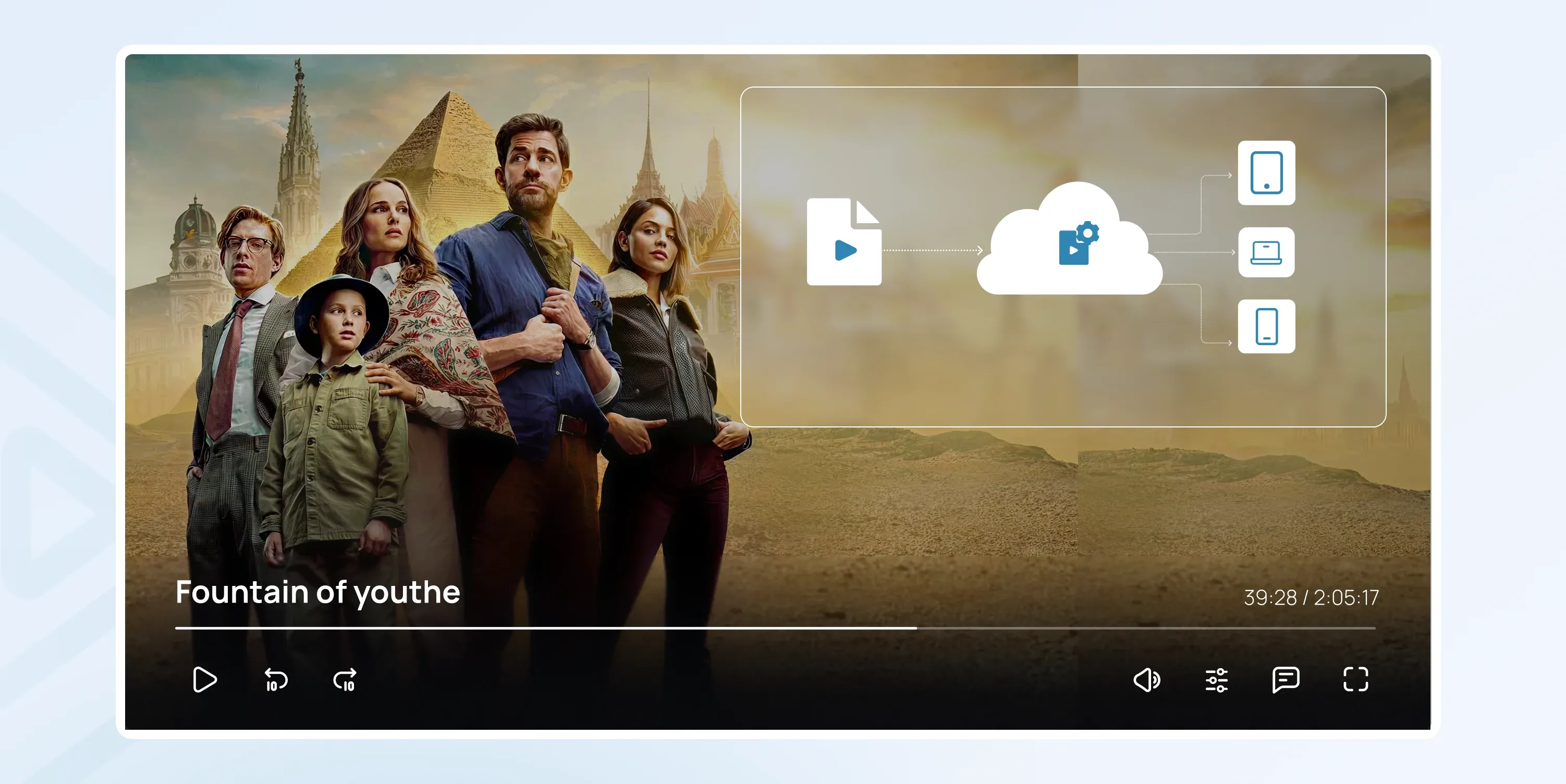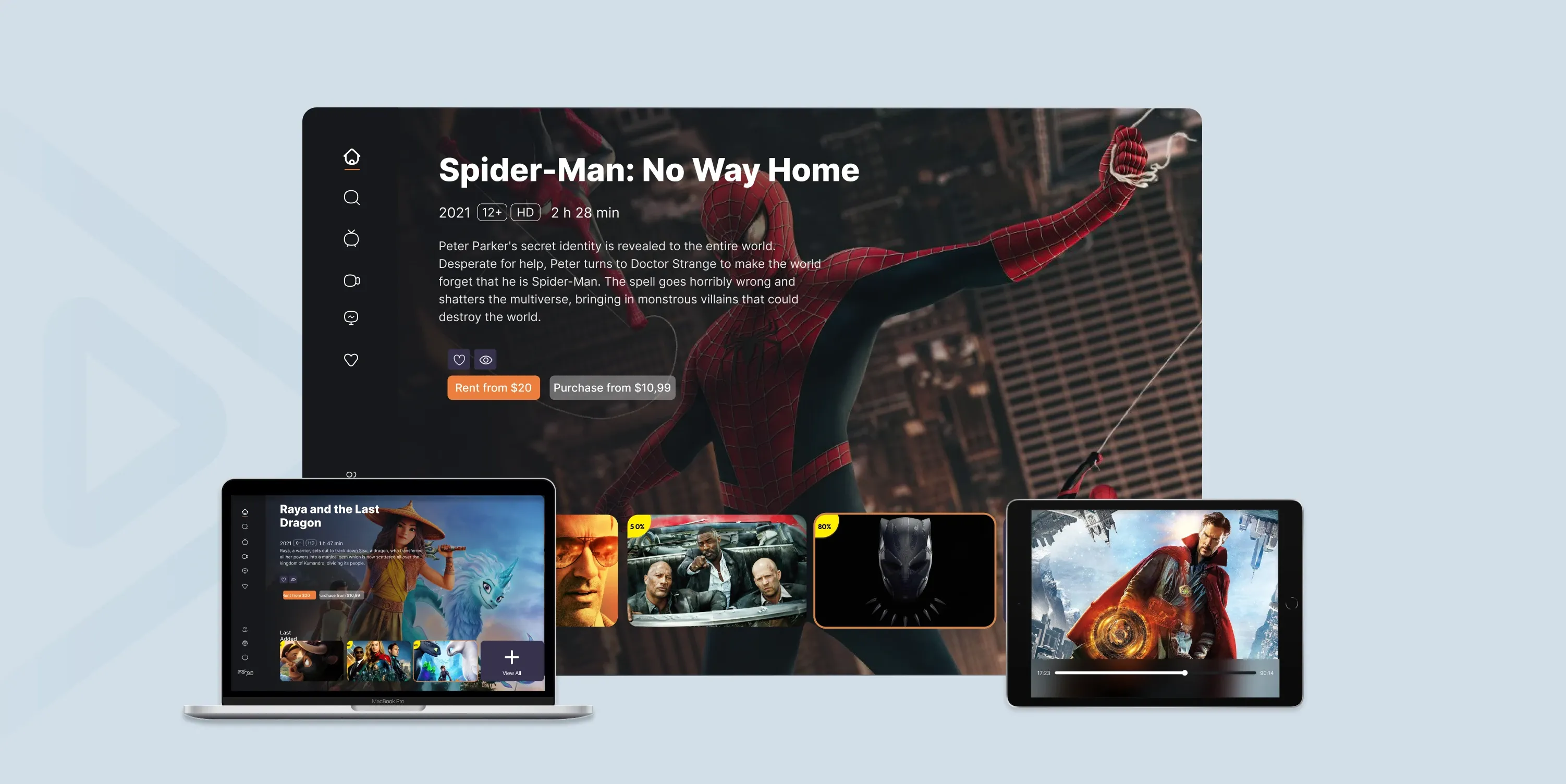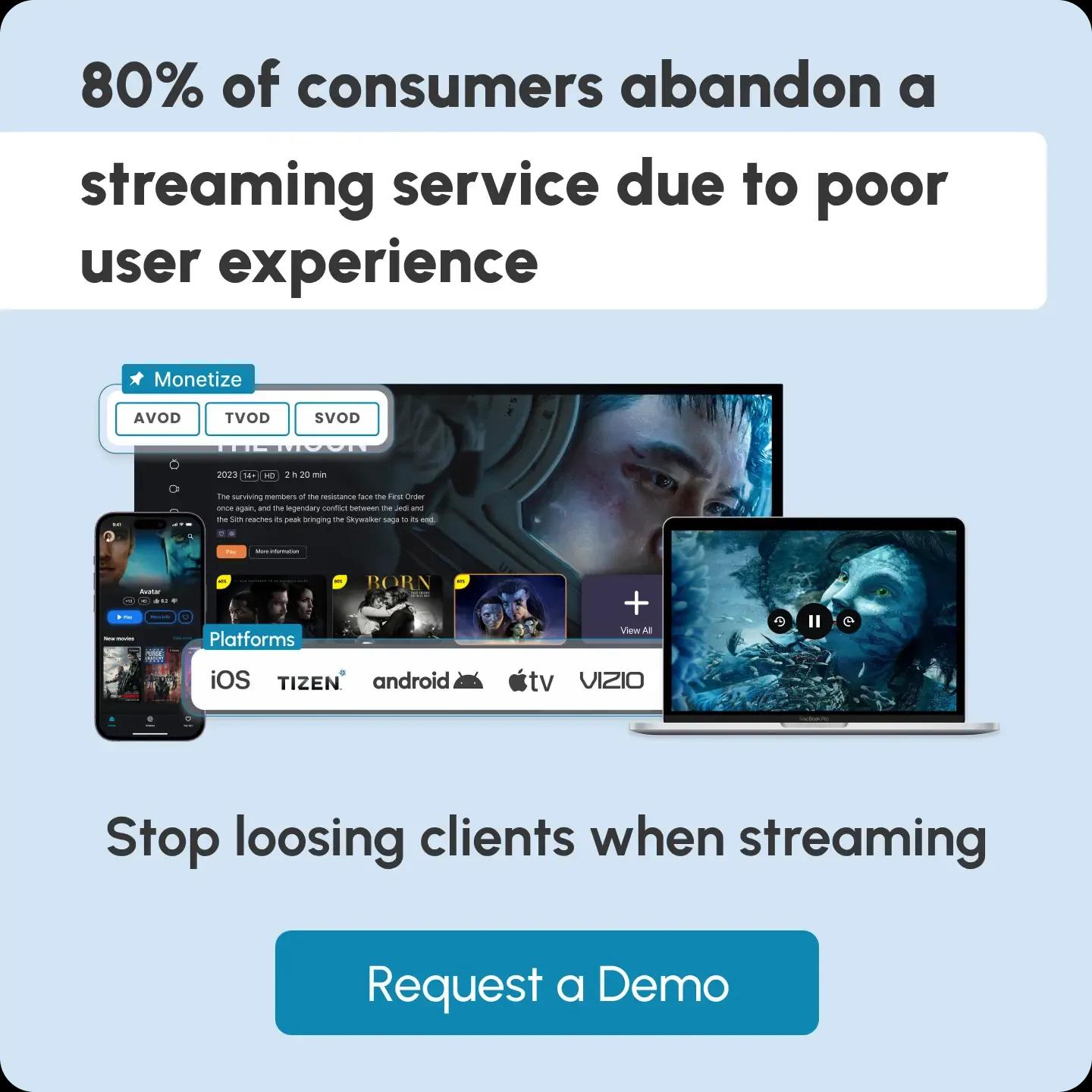
Cloud Transcoding: Scaling OTT, Live, and P2P Streaming
Before we explain cloud transcoding, here's a little spoiler: you’ll ensure seamless content delivery, regardless of a viewer's device or network conditions.
Cloud transcoding is almost the same as traditional transcoding, except that the processes happen within the cloud. It is an essential technology for live streamers, OTT platforms, and P2P streaming.
In this article, you'll discover what cloud transcoding is, how it works, its key benefits, and how it can help scale your streaming business.

Key Takeaways
- Cloud transcoding optimizes content formats and bitrates to match the viewer’s network and device for smooth playback.
- When selecting a cloud transcoding service, consider input/output formats, scalability, latency, speed, cost, compliance, security, metadata handling, and integration.
- Cloud transcoding offers many benefits, including high scalability, cost-effectiveness, fast processing, adaptive bitrate, automatic updates, and data security.
What is Cloud Transcoding?
Cloud transcoding is the process of converting a video file into multiple formats, resolutions, and bitrates entirely within the cloud. Cloud transcoding dynamically adjusts video quality and ensures seamless playback across various devices and network conditions.
In streaming, delivering high-quality content to diverse audiences is a priority. Cloud video transcoding allows platforms to provide smooth viewing experiences, whether on high-speed broadband, Wi-Fi, or mobile data. It ensures compatibility across devices, supports adaptive bitrate streaming (ABR), and reduces buffering. All these are key factors for OTT platforms, live streaming, and P2P networks.
Many confuse “cloud encoding” with “cloud transcoding.” These two terms are very similar but have one key difference. Simply put, cloud encoding is about converting non-streamable files into streamable formats. Cloud transcoding takes the existing video file and generates multiple versions optimized for different screens, bandwidths, and playback conditions.
How Cloud Transcoding Works
Broadcasters and live streamers record content using various devices - laptops, smartphones, and cameras. Ensuring that this content plays smoothly across different platforms and devices is challenging and essential. Cloud transcoding simplifies this process by converting a single video into multiple optimized formats.
Here’s how cloud transcoding works in 4 steps:
Step 1: Upload the Source File
The process begins by uploading the source file to the cloud transcoding service. This can be done manually or automatically via API integration.
Step 2: Choose the Output File Formats
The next step is choosing the formats, resolutions, bitrates, and codecs for the transcoded file. This specifically depends on the devices or platforms your viewers usually use to view your videos.
Step 3: The Transcoding Process
This step involves decoding the original file and re-encoding it in the desired formats.
Step 4: Content Delivery
Once the transcoding is done, the transcoded files are saved on a content delivery network (CDN) or cloud storage service. Users can now access, view, or download these files.
Key Considerations for Cloud Transcoding
Choosing the right cloud transcoding service involves several key factors that impact video quality, performance, and cost. Here’s what to keep in mind:
Input and Output Formats
Ensure the service supports your media formats. Standard video formats include MP4, MKV, and MOV, while audio formats include MP3 and AAC. Unsupported formats can lead to playback issues.
Scalability
If you're handling large volumes of content, choose a service that can efficiently scale without performance drops. This is crucial for OTT platforms and live streaming.
Latency and Speed
If you need your content to be transcoded in real time, look for low-latency solutions that can process and deliver video instantly to avoid streaming delays.
Adaptive Bitrate Streaming
The top cloud video transcoding solutions create multiple video versions using adaptive bitrate. This means your viewers can enjoy smooth playback, no matter their network conditions.
Costs
Video cloud transcoding services have different pricing models. Some charge based on the file size, number of files, or duration of the transcoding process. Consider your usage needs and budget to choose a package that suits your needs.
Compliance and Security
Another key factor to consider is security. Choose a transcoder that uses encryption to protect your files from unauthorized access and ensure compliance with industry security standards.
Metadata Handling
Some files contain essential metadata like timecodes, captions, or embedded subtitles. Make sure your chosen service allows you to keep all that critical data.
Integration with Other Services
If automation is a priority, opt for the best cloud video transcoding software that offers API support. Also, check for CDN integration to enhance content delivery speed.
7 Benefits of Cloud Transcoding
Using cloud transcoding offers multiple advantages over traditional on-premises solutions. Here are some of them:
1. High Scalability
Compared to on-premises transcoding, cloud transcoding isn’t limited by local server capacity. These services can handle thousands of videos, which is a lifesaver for big companies with large-scale media libraries and high traffic.
2. Cost-Effectiveness
Top cloud video transcoding solutions usually use the pay-per-use pricing model, meaning there’s no monthly subscription fee. Instead, you only pay for the resources you use, like processing time and storage.
3. Fast Processing
Cloud video transcoding usually uses multiple servers at the same time, which reduces delays and speeds up the conversion process.
4. Automatic Updates
Most cloud transcoding solutions update their platforms with the latest codecs, formats, and transcoding technologies, meaning you don’t need to do this manually.
5. Easy Integration with Workflows
Many cloud transcoding providers offer APIs, enabling easy integration with existing workflows and automation tools. It helps to have this level of flexibility and versatility as a user.
6. Data Security
All the best cloud transcoding software providers offer robust security. They use encryption at both the input and output stages to prevent unauthorized access. Additionally, they comply with regulations like GDPR, HIPAA, and SOC 2, meaning they securely handle sensitive data.
7. Better File Storage and Organization
Cloud transcoding typically comes with centralized storage, which makes it easy to access, organize, and edit large media libraries.
Cloud Transcoding in OTT, Live Streaming, and P2P Streaming

Cloud Transcoding in OTT Platforms
OTT platforms stream content over the internet, requiring videos to be available in multiple resolutions and formats. Cloud video transcoding ensures device compatibility by automatically adjusting quality using adaptive bitrate streaming.
This optimizes the viewing experience based on the user’s bandwidth. Additionally, cloud-based transcoding often integrates with content delivery networks (CDNs) to reduce buffering and improve load times for global audiences.
Cloud Transcoding in Live Streaming
For live streaming, cloud transcoding processes video in real time, adjusting bitrates and formats to match each viewer’s network conditions. This ensures smooth playback with minimal interruptions.
Many live cloud transcoding services prioritize low-latency delivery, making them ideal for live events, interactive broadcasts, and multi-platform streaming. With cloud-based transcoding, live broadcasters can effortlessly distribute content to multiple platforms like YouTube, Facebook, and Twitch, which is essential for monetization.
Cloud Transcoding in P2P Streaming
In P2P streaming, content is shared directly between users. Cloud transcoding converts files into multiple formats, ensuring compatibility across various devices and network speeds.
Unlike traditional methods, cloud transcoding minimizes storage costs by processing content only when needed.
Looking to benefit from OTT streaming? inoRain offers tailored solutions with comprehensive tools for content creators, TV operators, and even hotels. With our custom OTT platform solutions, you get seamless media management, high-quality streaming, and optimized delivery across multiple devices and networks.
Whether you need a scalable streaming solution, a custom, branded OTT app, or better ways to reach your audience and monetize your content, inoRain helps you deliver the best viewing experience.
Get Your White-Label OTT Platform
Conclusion
In this article, we’ve explored how cloud transcoding works, its key benefits, and real-world applications in OTT, live streaming, and P2P streaming.
By leveraging cloud-based transcoding, you can ensure your media content remains secure, accessible, and optimized for all viewers, regardless of device or network quality.
FAQs
Which codecs are commonly used in cloud transcoding?
Several widely used codecs in cloud transcoding include H.266, AV1, VP9, H.264, and MPEG-2. These codecs help optimize video quality while reducing file size and bandwidth consumption.
Can cloud transcoding handle live streaming?
Yes, cloud transcoding can handle live streaming, adjusting the video formats and bitrates in real time, and ensuring each device (regardless of the internet speed) gets smooth streaming.
How does cloud transcoding integrate with CDNs?
Cloud transcoding integrates with CDNs by converting video files into multiple formats and bitrates before delivering them to a content delivery network (CDN). The CDN then caches and distributes the optimized content, reducing latency and improving streaming performance for viewers worldwide.
Is cloud transcoding useful for P2P streaming?
Yes, cloud transcoding is useful for P2P streaming by ensuring that shared content is available in compatible formats for all peers, improving accessibility and playback quality across different devices and networks.
How does latency affect live cloud transcoding?
Latency can cause a delay between real-time events and what viewers see on their screens. High latency may lead to noticeable lags, impacting interactive experiences such as live sports, gaming, or virtual events. Low-latency cloud video transcoding solutions help minimize these delays for a smoother viewing experience.
Co-founder / CTO
Hi, I'm Armen, the CTO and Co-Founder of inoRain OTT, as well as the Co-Founder of HotelSmarters. With 15+ years of background in digital streaming technology, I specialize in OTT strategies and interactive TV solutions, helping businesses maximize their revenue potential. At HotelSmarters, I focus on leveraging tech to transform hotel operations, while at inoRain, I drive innovation in end-to-end OTT solutions. Let’s connect and explore new opportunities!

VPlayed Alternatives: inoRain vs. VPlayed
Explore inoRain as a VPlayed alternative, comparing features, pricing, and OTT solutions to find the best platform for your streaming needs.

Live Streaming CDN: Reduce Latency and Improve Quality
Discover live streaming CDN solutions, how they work, and their benefits. Learn how CDNs enhance video quality, reduce latency, and ensure viewer satisfaction.

Why Amazon Switches Fire TV to Vega OS? A New Era Beyond Android
A whole ecosystem doesn't shift overnight, so Amazon's move to Vega OS has been years in the making. Here are all the benefits for Amazon and it's users.
